Introduction to Marketing: Lidl's Market Analysis and Strategies
VerifiedAdded on 2020/06/03
|22
|6181
|89
Report
AI Summary
This report provides a comprehensive analysis of Lidl's marketing strategies and market position within the UK grocery retail sector. It begins with an introduction to the market and its key players, highlighting Lidl's growth and market share. The report then delves into a detailed SWOT analysis, examining Lidl's strengths, weaknesses, opportunities, and threats. A PESTLE analysis is conducted to assess the political, economic, social, technological, legal, and environmental factors impacting the company. The report further explores the competitive landscape using a competitor matrix and the BCG growth matrix to evaluate product portfolios. Ansoff's matrix is also used to assess growth strategies. The report concludes with recommendations for managing challenges and risks, aiming to enhance Lidl's profitability and market expansion in the grocery and retail sectors. Various marketing models and theories are explained to provide a comprehensive overview of Lidl's current market position and future opportunities.
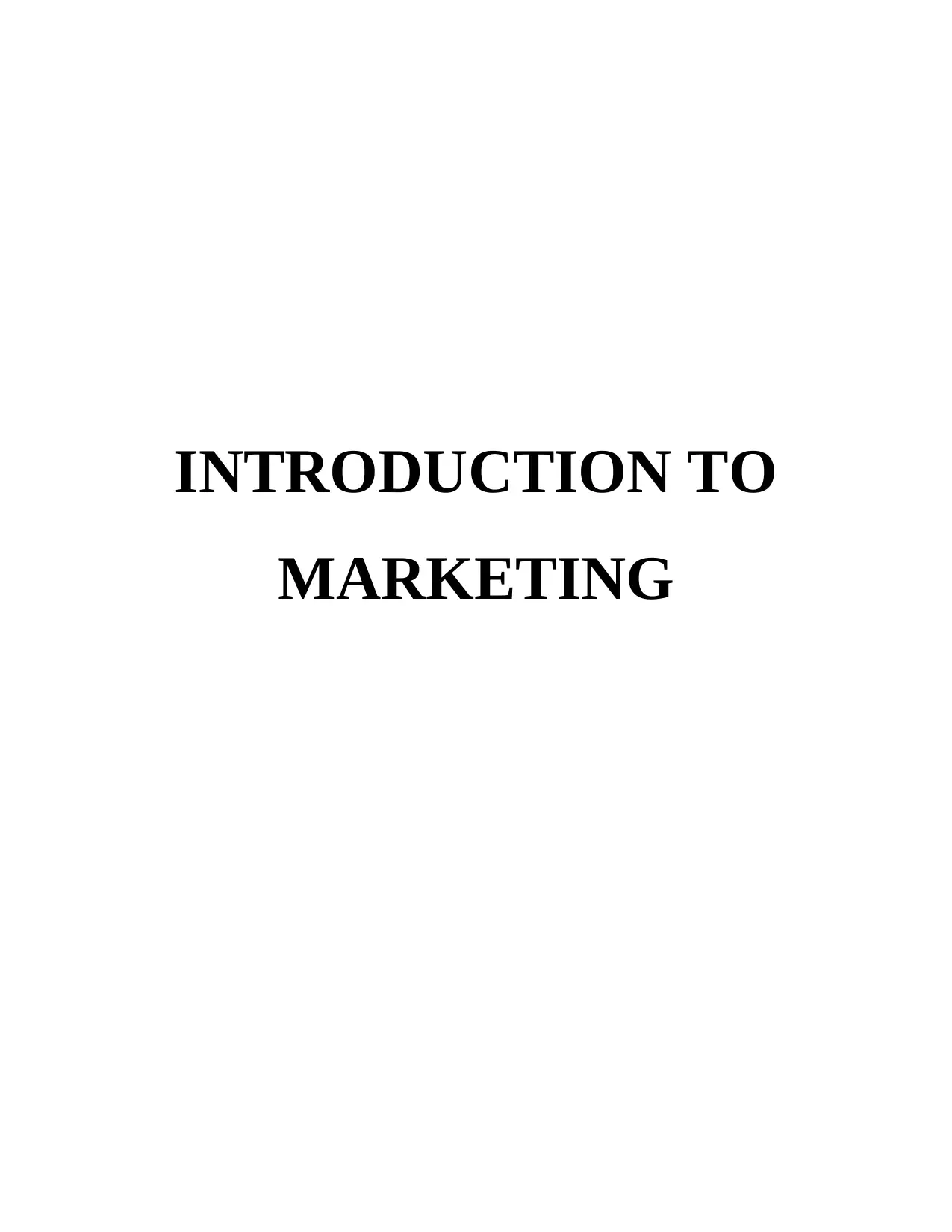
INTRODUCTION TO
MARKETING
MARKETING
Paraphrase This Document
Need a fresh take? Get an instant paraphrase of this document with our AI Paraphraser
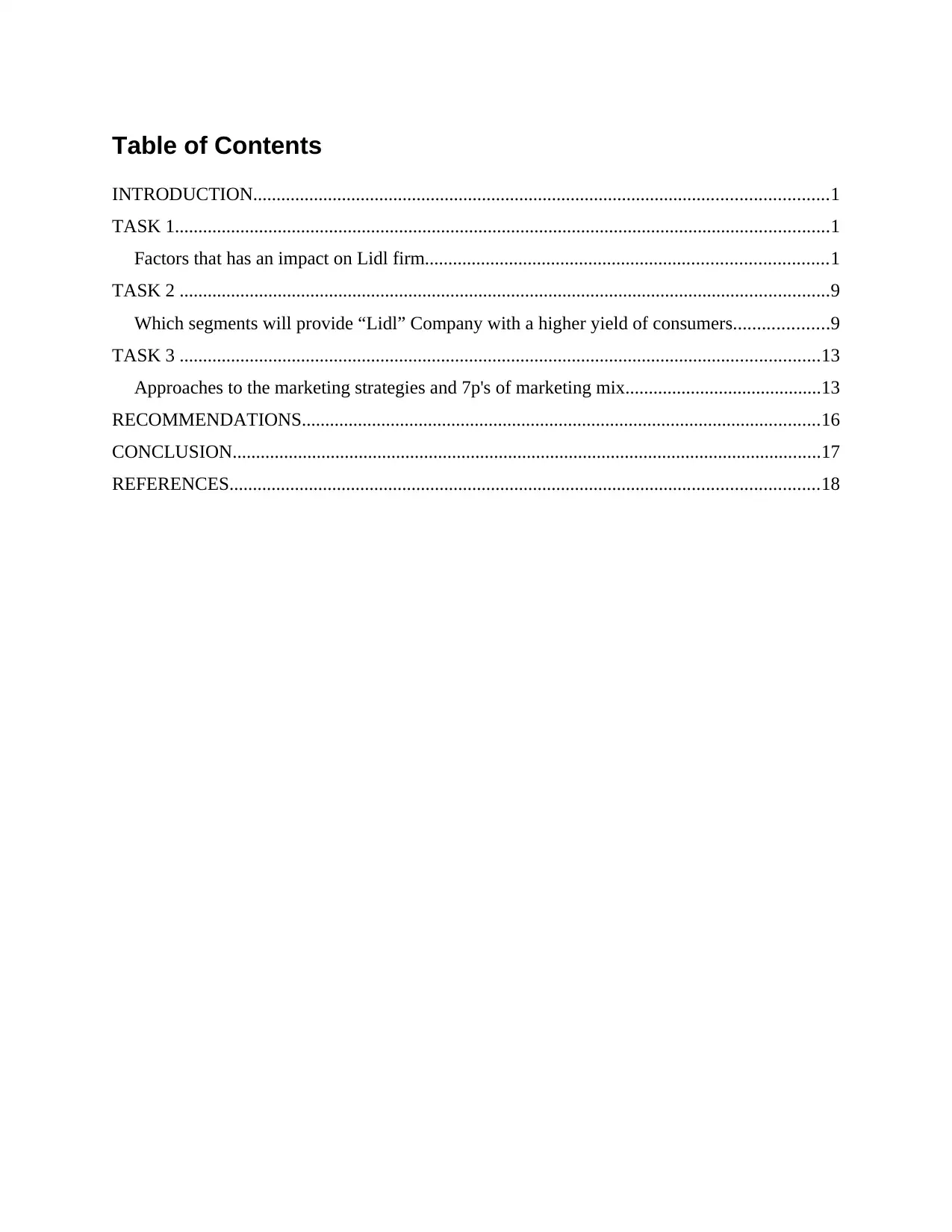
Table of Contents
INTRODUCTION...........................................................................................................................1
TASK 1............................................................................................................................................1
Factors that has an impact on Lidl firm......................................................................................1
TASK 2 ...........................................................................................................................................9
Which segments will provide “Lidl” Company with a higher yield of consumers....................9
TASK 3 .........................................................................................................................................13
Approaches to the marketing strategies and 7p's of marketing mix..........................................13
RECOMMENDATIONS...............................................................................................................16
CONCLUSION..............................................................................................................................17
REFERENCES..............................................................................................................................18
INTRODUCTION...........................................................................................................................1
TASK 1............................................................................................................................................1
Factors that has an impact on Lidl firm......................................................................................1
TASK 2 ...........................................................................................................................................9
Which segments will provide “Lidl” Company with a higher yield of consumers....................9
TASK 3 .........................................................................................................................................13
Approaches to the marketing strategies and 7p's of marketing mix..........................................13
RECOMMENDATIONS...............................................................................................................16
CONCLUSION..............................................................................................................................17
REFERENCES..............................................................................................................................18
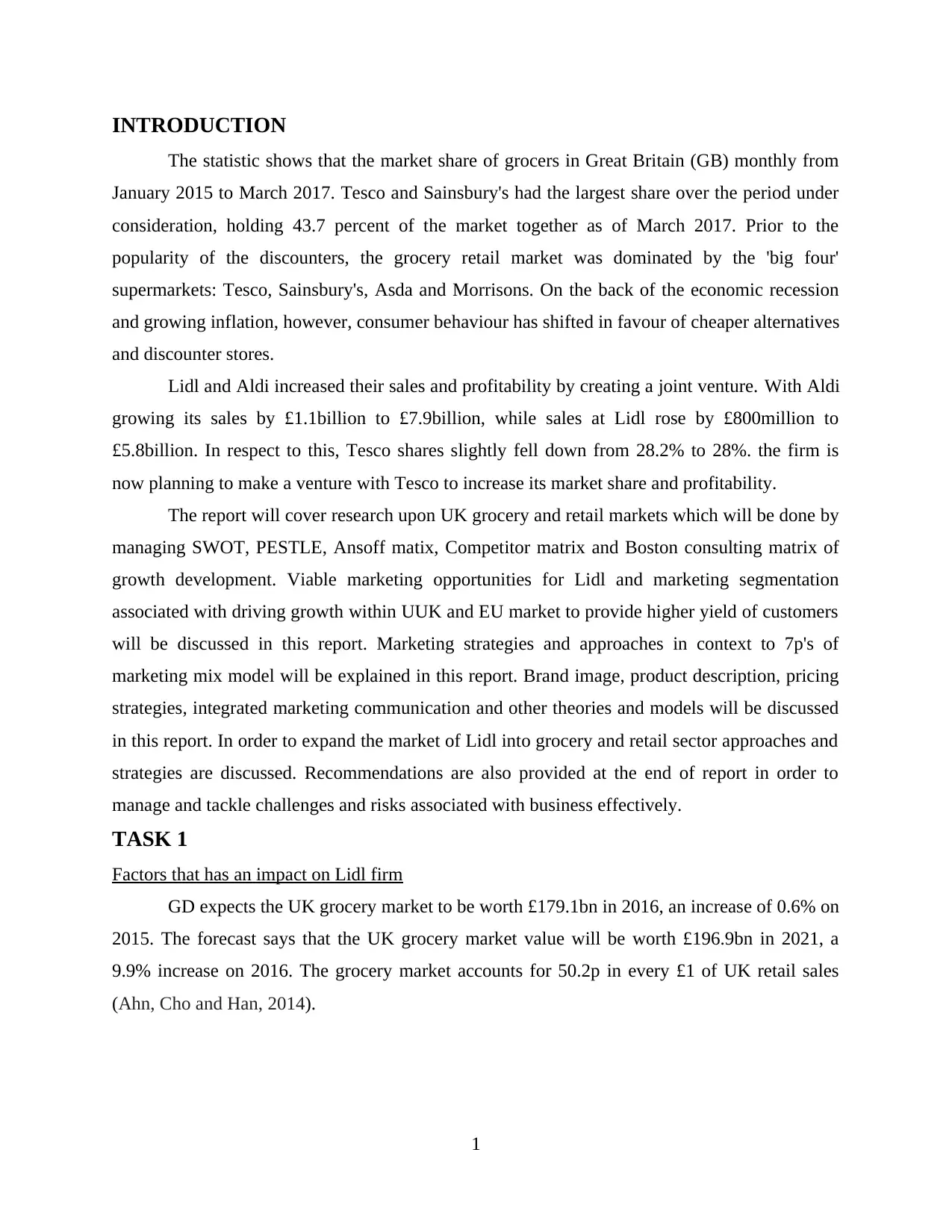
INTRODUCTION
The statistic shows that the market share of grocers in Great Britain (GB) monthly from
January 2015 to March 2017. Tesco and Sainsbury's had the largest share over the period under
consideration, holding 43.7 percent of the market together as of March 2017. Prior to the
popularity of the discounters, the grocery retail market was dominated by the 'big four'
supermarkets: Tesco, Sainsbury's, Asda and Morrisons. On the back of the economic recession
and growing inflation, however, consumer behaviour has shifted in favour of cheaper alternatives
and discounter stores.
Lidl and Aldi increased their sales and profitability by creating a joint venture. With Aldi
growing its sales by £1.1billion to £7.9billion, while sales at Lidl rose by £800million to
£5.8billion. In respect to this, Tesco shares slightly fell down from 28.2% to 28%. the firm is
now planning to make a venture with Tesco to increase its market share and profitability.
The report will cover research upon UK grocery and retail markets which will be done by
managing SWOT, PESTLE, Ansoff matix, Competitor matrix and Boston consulting matrix of
growth development. Viable marketing opportunities for Lidl and marketing segmentation
associated with driving growth within UUK and EU market to provide higher yield of customers
will be discussed in this report. Marketing strategies and approaches in context to 7p's of
marketing mix model will be explained in this report. Brand image, product description, pricing
strategies, integrated marketing communication and other theories and models will be discussed
in this report. In order to expand the market of Lidl into grocery and retail sector approaches and
strategies are discussed. Recommendations are also provided at the end of report in order to
manage and tackle challenges and risks associated with business effectively.
TASK 1
Factors that has an impact on Lidl firm
GD expects the UK grocery market to be worth £179.1bn in 2016, an increase of 0.6% on
2015. The forecast says that the UK grocery market value will be worth £196.9bn in 2021, a
9.9% increase on 2016. The grocery market accounts for 50.2p in every £1 of UK retail sales
(Ahn, Cho and Han, 2014).
1
The statistic shows that the market share of grocers in Great Britain (GB) monthly from
January 2015 to March 2017. Tesco and Sainsbury's had the largest share over the period under
consideration, holding 43.7 percent of the market together as of March 2017. Prior to the
popularity of the discounters, the grocery retail market was dominated by the 'big four'
supermarkets: Tesco, Sainsbury's, Asda and Morrisons. On the back of the economic recession
and growing inflation, however, consumer behaviour has shifted in favour of cheaper alternatives
and discounter stores.
Lidl and Aldi increased their sales and profitability by creating a joint venture. With Aldi
growing its sales by £1.1billion to £7.9billion, while sales at Lidl rose by £800million to
£5.8billion. In respect to this, Tesco shares slightly fell down from 28.2% to 28%. the firm is
now planning to make a venture with Tesco to increase its market share and profitability.
The report will cover research upon UK grocery and retail markets which will be done by
managing SWOT, PESTLE, Ansoff matix, Competitor matrix and Boston consulting matrix of
growth development. Viable marketing opportunities for Lidl and marketing segmentation
associated with driving growth within UUK and EU market to provide higher yield of customers
will be discussed in this report. Marketing strategies and approaches in context to 7p's of
marketing mix model will be explained in this report. Brand image, product description, pricing
strategies, integrated marketing communication and other theories and models will be discussed
in this report. In order to expand the market of Lidl into grocery and retail sector approaches and
strategies are discussed. Recommendations are also provided at the end of report in order to
manage and tackle challenges and risks associated with business effectively.
TASK 1
Factors that has an impact on Lidl firm
GD expects the UK grocery market to be worth £179.1bn in 2016, an increase of 0.6% on
2015. The forecast says that the UK grocery market value will be worth £196.9bn in 2021, a
9.9% increase on 2016. The grocery market accounts for 50.2p in every £1 of UK retail sales
(Ahn, Cho and Han, 2014).
1
⊘ This is a preview!⊘
Do you want full access?
Subscribe today to unlock all pages.

Trusted by 1+ million students worldwide
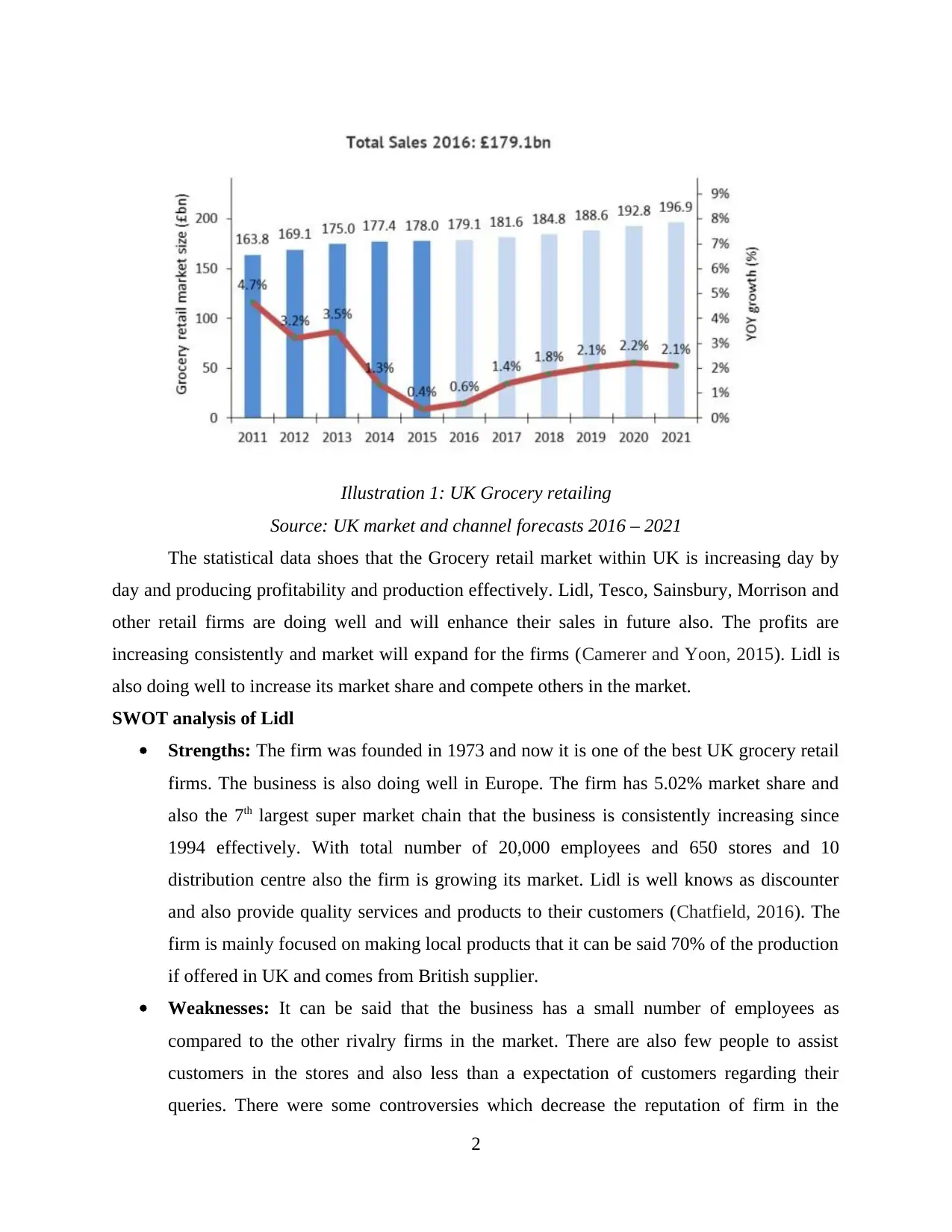
Illustration 1: UK Grocery retailing
Source: UK market and channel forecasts 2016 – 2021
The statistical data shoes that the Grocery retail market within UK is increasing day by
day and producing profitability and production effectively. Lidl, Tesco, Sainsbury, Morrison and
other retail firms are doing well and will enhance their sales in future also. The profits are
increasing consistently and market will expand for the firms (Camerer and Yoon, 2015). Lidl is
also doing well to increase its market share and compete others in the market.
SWOT analysis of Lidl
Strengths: The firm was founded in 1973 and now it is one of the best UK grocery retail
firms. The business is also doing well in Europe. The firm has 5.02% market share and
also the 7th largest super market chain that the business is consistently increasing since
1994 effectively. With total number of 20,000 employees and 650 stores and 10
distribution centre also the firm is growing its market. Lidl is well knows as discounter
and also provide quality services and products to their customers (Chatfield, 2016). The
firm is mainly focused on making local products that it can be said 70% of the production
if offered in UK and comes from British supplier.
Weaknesses: It can be said that the business has a small number of employees as
compared to the other rivalry firms in the market. There are also few people to assist
customers in the stores and also less than a expectation of customers regarding their
queries. There were some controversies which decrease the reputation of firm in the
2
Source: UK market and channel forecasts 2016 – 2021
The statistical data shoes that the Grocery retail market within UK is increasing day by
day and producing profitability and production effectively. Lidl, Tesco, Sainsbury, Morrison and
other retail firms are doing well and will enhance their sales in future also. The profits are
increasing consistently and market will expand for the firms (Camerer and Yoon, 2015). Lidl is
also doing well to increase its market share and compete others in the market.
SWOT analysis of Lidl
Strengths: The firm was founded in 1973 and now it is one of the best UK grocery retail
firms. The business is also doing well in Europe. The firm has 5.02% market share and
also the 7th largest super market chain that the business is consistently increasing since
1994 effectively. With total number of 20,000 employees and 650 stores and 10
distribution centre also the firm is growing its market. Lidl is well knows as discounter
and also provide quality services and products to their customers (Chatfield, 2016). The
firm is mainly focused on making local products that it can be said 70% of the production
if offered in UK and comes from British supplier.
Weaknesses: It can be said that the business has a small number of employees as
compared to the other rivalry firms in the market. There are also few people to assist
customers in the stores and also less than a expectation of customers regarding their
queries. There were some controversies which decrease the reputation of firm in the
2
Paraphrase This Document
Need a fresh take? Get an instant paraphrase of this document with our AI Paraphraser

market. For instance, the company was accused of spying on its employees across
Germany in 2008. Spying included but not limited to recording the number of times
employees went to the toilet, and their very personal details.
Opportunities:There are a lot of opportunities available for the firm in order to expand
its business such as Lidl currently has 10,000 stores in 27 European countries that it can
be said that there are so many potential areas remaining where the firm is able to expand
its business and operational activities (Eagle and Dahl, 2015). The firm is fastest growing
organisation within UK in super market chain. The firm has also an opportunity to
develop its business in USA as well. The plan is to open 600 new stores that Tesco is
failed to expand its operations. Some initial steps and strategies will help to grow the
market in USA.
Threats: The retail and grocery sector is increasing in UK that there are so many
competitors in the market such as Tesco, Sainsbury, Morrison and Asda which is
affecting the business of Lidl. Tesco, Aldi and Sainsbury leading the market in Europe
and also tough competitors. Changes in consumer behaviour, and any political instability
in Europe may impact on Lidl significantly. It may sound harsh; however, any increase in
minimum wages may also impact on the company profitability effectively and efficiently.
The firm should take some necessary steps in order to enhance profitability and
production.
PESTLE analysis of Lidl
Political: Political factors should be managed and controlled by firm in order to manage
its operational activities in 10,000 stores within Europe and UK (Ewing and Ramaseshan,
2015). Natural assurance law is one of the major components which is affecting the
business and operational activities of Lidl. The firm should comply with all the
government needs in order to run business successfully and effectively. The UK
government vitality advance program to do work of retail products and services
innovatively is also affecting the business. Changes in interest rates and other policies
will affect the business of Lidl.
Economical: Ecnomical factors such as internal and external affect the business of Lidl
that there are so many rules and legislations formulated by the government in order to
improve the economy level. Consequently, recuperation of GDP and the rising rate in the
3
Germany in 2008. Spying included but not limited to recording the number of times
employees went to the toilet, and their very personal details.
Opportunities:There are a lot of opportunities available for the firm in order to expand
its business such as Lidl currently has 10,000 stores in 27 European countries that it can
be said that there are so many potential areas remaining where the firm is able to expand
its business and operational activities (Eagle and Dahl, 2015). The firm is fastest growing
organisation within UK in super market chain. The firm has also an opportunity to
develop its business in USA as well. The plan is to open 600 new stores that Tesco is
failed to expand its operations. Some initial steps and strategies will help to grow the
market in USA.
Threats: The retail and grocery sector is increasing in UK that there are so many
competitors in the market such as Tesco, Sainsbury, Morrison and Asda which is
affecting the business of Lidl. Tesco, Aldi and Sainsbury leading the market in Europe
and also tough competitors. Changes in consumer behaviour, and any political instability
in Europe may impact on Lidl significantly. It may sound harsh; however, any increase in
minimum wages may also impact on the company profitability effectively and efficiently.
The firm should take some necessary steps in order to enhance profitability and
production.
PESTLE analysis of Lidl
Political: Political factors should be managed and controlled by firm in order to manage
its operational activities in 10,000 stores within Europe and UK (Ewing and Ramaseshan,
2015). Natural assurance law is one of the major components which is affecting the
business and operational activities of Lidl. The firm should comply with all the
government needs in order to run business successfully and effectively. The UK
government vitality advance program to do work of retail products and services
innovatively is also affecting the business. Changes in interest rates and other policies
will affect the business of Lidl.
Economical: Ecnomical factors such as internal and external affect the business of Lidl
that there are so many rules and legislations formulated by the government in order to
improve the economy level. Consequently, recuperation of GDP and the rising rate in the
3
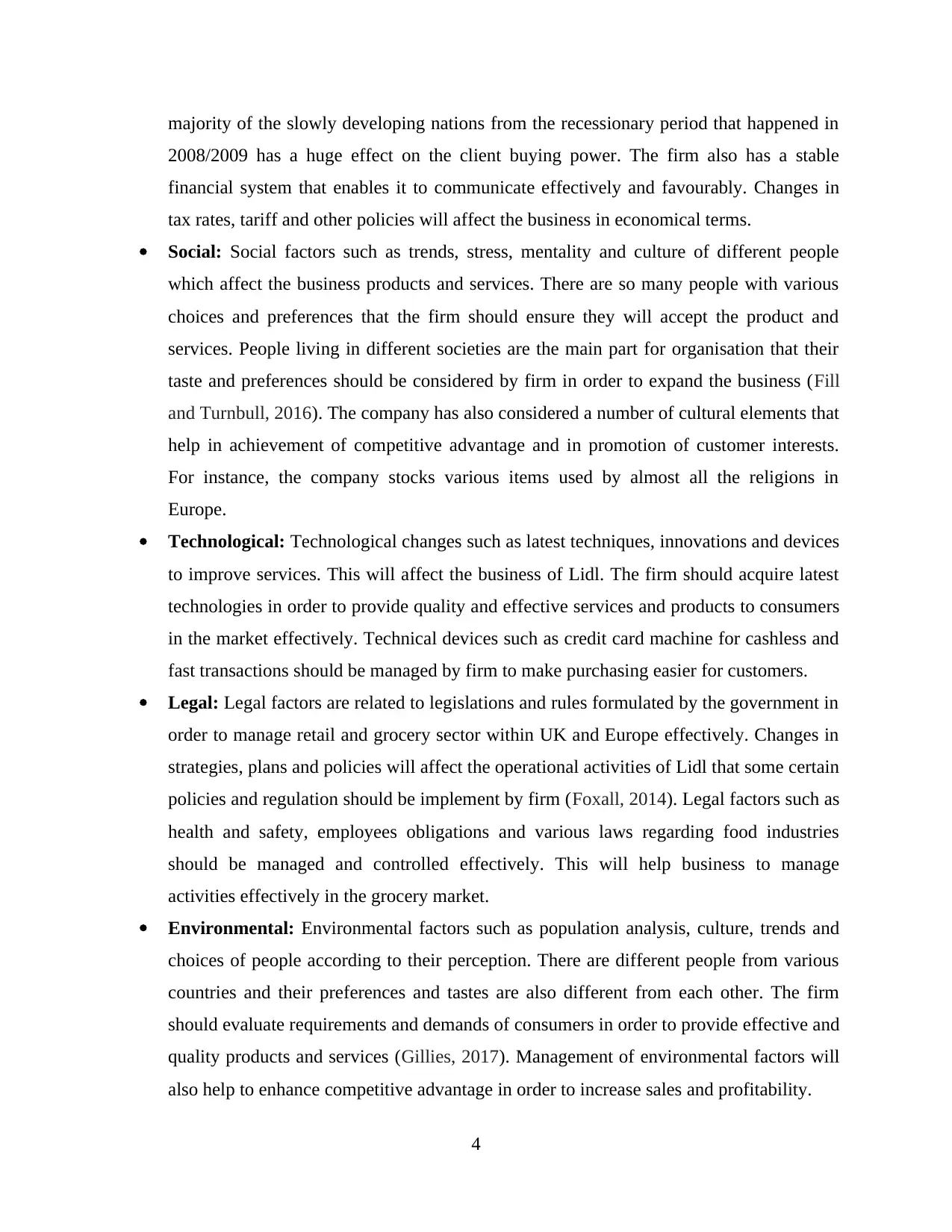
majority of the slowly developing nations from the recessionary period that happened in
2008/2009 has a huge effect on the client buying power. The firm also has a stable
financial system that enables it to communicate effectively and favourably. Changes in
tax rates, tariff and other policies will affect the business in economical terms.
Social: Social factors such as trends, stress, mentality and culture of different people
which affect the business products and services. There are so many people with various
choices and preferences that the firm should ensure they will accept the product and
services. People living in different societies are the main part for organisation that their
taste and preferences should be considered by firm in order to expand the business (Fill
and Turnbull, 2016). The company has also considered a number of cultural elements that
help in achievement of competitive advantage and in promotion of customer interests.
For instance, the company stocks various items used by almost all the religions in
Europe.
Technological: Technological changes such as latest techniques, innovations and devices
to improve services. This will affect the business of Lidl. The firm should acquire latest
technologies in order to provide quality and effective services and products to consumers
in the market effectively. Technical devices such as credit card machine for cashless and
fast transactions should be managed by firm to make purchasing easier for customers.
Legal: Legal factors are related to legislations and rules formulated by the government in
order to manage retail and grocery sector within UK and Europe effectively. Changes in
strategies, plans and policies will affect the operational activities of Lidl that some certain
policies and regulation should be implement by firm (Foxall, 2014). Legal factors such as
health and safety, employees obligations and various laws regarding food industries
should be managed and controlled effectively. This will help business to manage
activities effectively in the grocery market.
Environmental: Environmental factors such as population analysis, culture, trends and
choices of people according to their perception. There are different people from various
countries and their preferences and tastes are also different from each other. The firm
should evaluate requirements and demands of consumers in order to provide effective and
quality products and services (Gillies, 2017). Management of environmental factors will
also help to enhance competitive advantage in order to increase sales and profitability.
4
2008/2009 has a huge effect on the client buying power. The firm also has a stable
financial system that enables it to communicate effectively and favourably. Changes in
tax rates, tariff and other policies will affect the business in economical terms.
Social: Social factors such as trends, stress, mentality and culture of different people
which affect the business products and services. There are so many people with various
choices and preferences that the firm should ensure they will accept the product and
services. People living in different societies are the main part for organisation that their
taste and preferences should be considered by firm in order to expand the business (Fill
and Turnbull, 2016). The company has also considered a number of cultural elements that
help in achievement of competitive advantage and in promotion of customer interests.
For instance, the company stocks various items used by almost all the religions in
Europe.
Technological: Technological changes such as latest techniques, innovations and devices
to improve services. This will affect the business of Lidl. The firm should acquire latest
technologies in order to provide quality and effective services and products to consumers
in the market effectively. Technical devices such as credit card machine for cashless and
fast transactions should be managed by firm to make purchasing easier for customers.
Legal: Legal factors are related to legislations and rules formulated by the government in
order to manage retail and grocery sector within UK and Europe effectively. Changes in
strategies, plans and policies will affect the operational activities of Lidl that some certain
policies and regulation should be implement by firm (Foxall, 2014). Legal factors such as
health and safety, employees obligations and various laws regarding food industries
should be managed and controlled effectively. This will help business to manage
activities effectively in the grocery market.
Environmental: Environmental factors such as population analysis, culture, trends and
choices of people according to their perception. There are different people from various
countries and their preferences and tastes are also different from each other. The firm
should evaluate requirements and demands of consumers in order to provide effective and
quality products and services (Gillies, 2017). Management of environmental factors will
also help to enhance competitive advantage in order to increase sales and profitability.
4
⊘ This is a preview!⊘
Do you want full access?
Subscribe today to unlock all pages.

Trusted by 1+ million students worldwide

COMPETITOR MATRIX
The competition matrix will help Lidl to analyse its competitive advantage in order to
compete others in the grocery and retail market effectively. The chart provided below presents
different range of products and services offered by Lidl any many other grocery and retail sector
firms in the market towards customers. The price is different for each product and service that
some of them are selling a product costly, some affordable and some on the cheap prices. Thus, it
can be said that the firm is holding 3.5% of market share in 2014 and now it is increased to 5.2%
in 2017 effectively (Gopaldas, 2015). The firm is growing and developing its activities in order
to enhance profitability and production.
Illustration 2: Competitive Matrix
Sources: Richard, 2018
5
The competition matrix will help Lidl to analyse its competitive advantage in order to
compete others in the grocery and retail market effectively. The chart provided below presents
different range of products and services offered by Lidl any many other grocery and retail sector
firms in the market towards customers. The price is different for each product and service that
some of them are selling a product costly, some affordable and some on the cheap prices. Thus, it
can be said that the firm is holding 3.5% of market share in 2014 and now it is increased to 5.2%
in 2017 effectively (Gopaldas, 2015). The firm is growing and developing its activities in order
to enhance profitability and production.
Illustration 2: Competitive Matrix
Sources: Richard, 2018
5
Paraphrase This Document
Need a fresh take? Get an instant paraphrase of this document with our AI Paraphraser
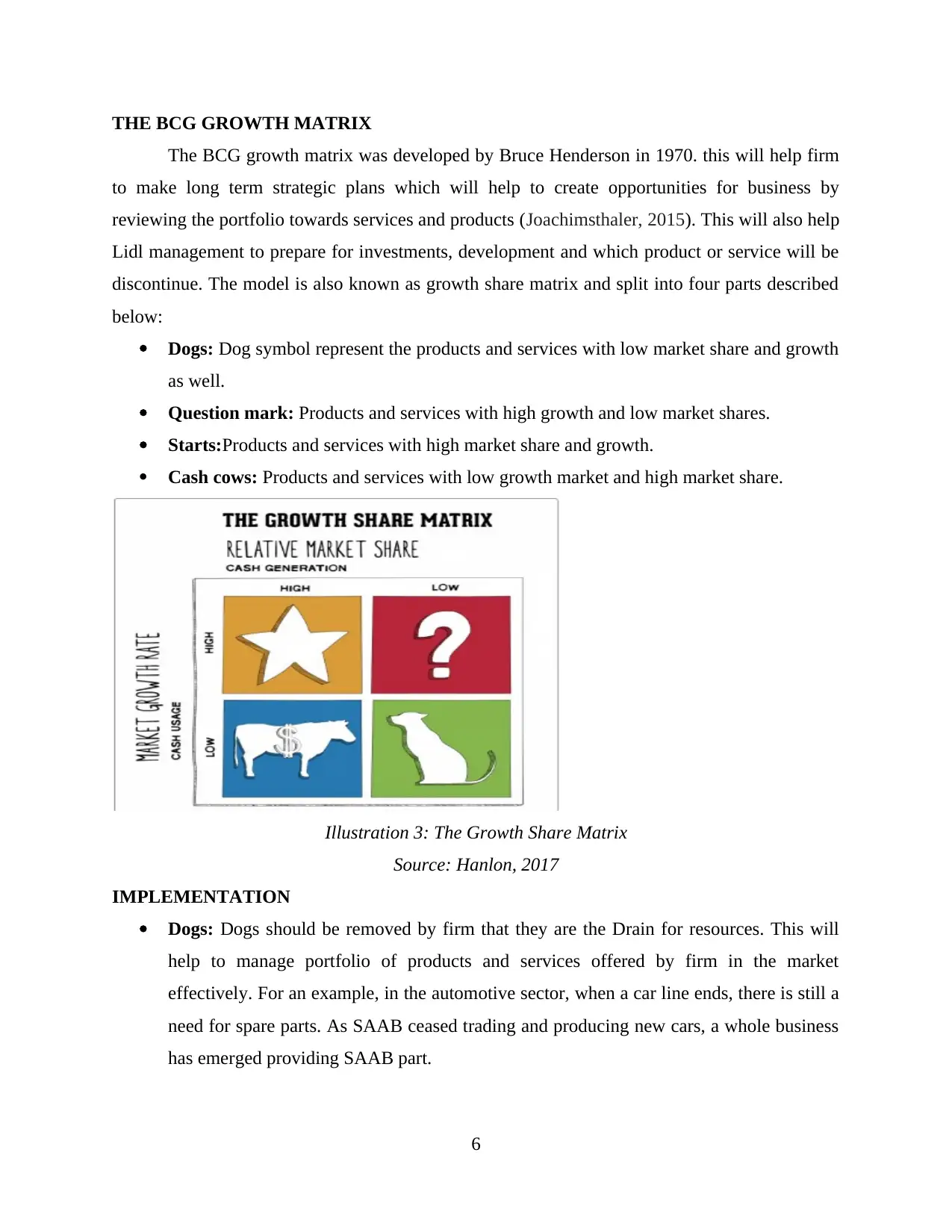
THE BCG GROWTH MATRIX
The BCG growth matrix was developed by Bruce Henderson in 1970. this will help firm
to make long term strategic plans which will help to create opportunities for business by
reviewing the portfolio towards services and products (Joachimsthaler, 2015). This will also help
Lidl management to prepare for investments, development and which product or service will be
discontinue. The model is also known as growth share matrix and split into four parts described
below:
Dogs: Dog symbol represent the products and services with low market share and growth
as well.
Question mark: Products and services with high growth and low market shares.
Starts:Products and services with high market share and growth.
Cash cows: Products and services with low growth market and high market share.
Illustration 3: The Growth Share Matrix
Source: Hanlon, 2017
IMPLEMENTATION
Dogs: Dogs should be removed by firm that they are the Drain for resources. This will
help to manage portfolio of products and services offered by firm in the market
effectively. For an example, in the automotive sector, when a car line ends, there is still a
need for spare parts. As SAAB ceased trading and producing new cars, a whole business
has emerged providing SAAB part.
6
The BCG growth matrix was developed by Bruce Henderson in 1970. this will help firm
to make long term strategic plans which will help to create opportunities for business by
reviewing the portfolio towards services and products (Joachimsthaler, 2015). This will also help
Lidl management to prepare for investments, development and which product or service will be
discontinue. The model is also known as growth share matrix and split into four parts described
below:
Dogs: Dog symbol represent the products and services with low market share and growth
as well.
Question mark: Products and services with high growth and low market shares.
Starts:Products and services with high market share and growth.
Cash cows: Products and services with low growth market and high market share.
Illustration 3: The Growth Share Matrix
Source: Hanlon, 2017
IMPLEMENTATION
Dogs: Dogs should be removed by firm that they are the Drain for resources. This will
help to manage portfolio of products and services offered by firm in the market
effectively. For an example, in the automotive sector, when a car line ends, there is still a
need for spare parts. As SAAB ceased trading and producing new cars, a whole business
has emerged providing SAAB part.
6
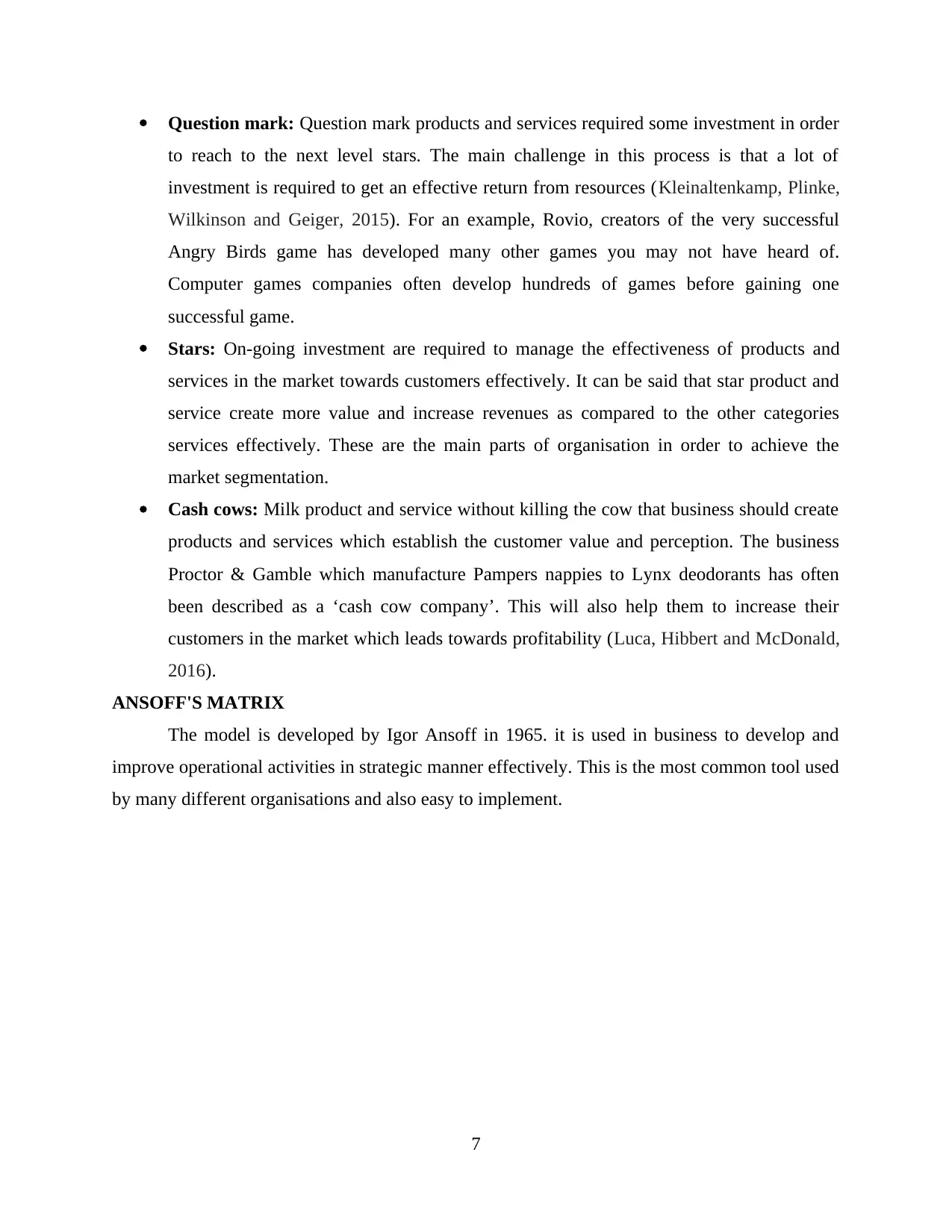
Question mark: Question mark products and services required some investment in order
to reach to the next level stars. The main challenge in this process is that a lot of
investment is required to get an effective return from resources (Kleinaltenkamp, Plinke,
Wilkinson and Geiger, 2015). For an example, Rovio, creators of the very successful
Angry Birds game has developed many other games you may not have heard of.
Computer games companies often develop hundreds of games before gaining one
successful game.
Stars: On-going investment are required to manage the effectiveness of products and
services in the market towards customers effectively. It can be said that star product and
service create more value and increase revenues as compared to the other categories
services effectively. These are the main parts of organisation in order to achieve the
market segmentation.
Cash cows: Milk product and service without killing the cow that business should create
products and services which establish the customer value and perception. The business
Proctor & Gamble which manufacture Pampers nappies to Lynx deodorants has often
been described as a ‘cash cow company’. This will also help them to increase their
customers in the market which leads towards profitability (Luca, Hibbert and McDonald,
2016).
ANSOFF'S MATRIX
The model is developed by Igor Ansoff in 1965. it is used in business to develop and
improve operational activities in strategic manner effectively. This is the most common tool used
by many different organisations and also easy to implement.
7
to reach to the next level stars. The main challenge in this process is that a lot of
investment is required to get an effective return from resources (Kleinaltenkamp, Plinke,
Wilkinson and Geiger, 2015). For an example, Rovio, creators of the very successful
Angry Birds game has developed many other games you may not have heard of.
Computer games companies often develop hundreds of games before gaining one
successful game.
Stars: On-going investment are required to manage the effectiveness of products and
services in the market towards customers effectively. It can be said that star product and
service create more value and increase revenues as compared to the other categories
services effectively. These are the main parts of organisation in order to achieve the
market segmentation.
Cash cows: Milk product and service without killing the cow that business should create
products and services which establish the customer value and perception. The business
Proctor & Gamble which manufacture Pampers nappies to Lynx deodorants has often
been described as a ‘cash cow company’. This will also help them to increase their
customers in the market which leads towards profitability (Luca, Hibbert and McDonald,
2016).
ANSOFF'S MATRIX
The model is developed by Igor Ansoff in 1965. it is used in business to develop and
improve operational activities in strategic manner effectively. This is the most common tool used
by many different organisations and also easy to implement.
7
⊘ This is a preview!⊘
Do you want full access?
Subscribe today to unlock all pages.

Trusted by 1+ million students worldwide
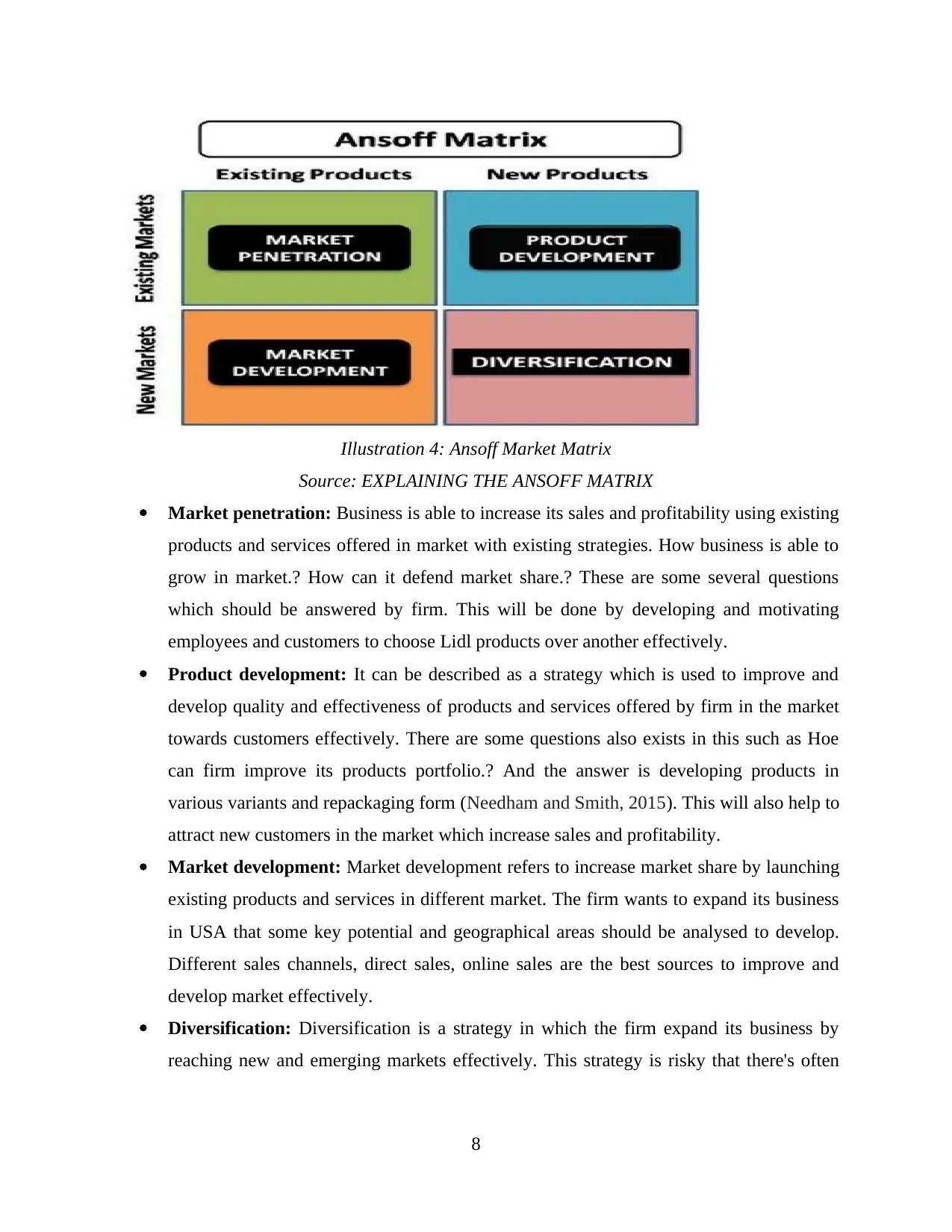
Illustration 4: Ansoff Market Matrix
Source: EXPLAINING THE ANSOFF MATRIX
Market penetration: Business is able to increase its sales and profitability using existing
products and services offered in market with existing strategies. How business is able to
grow in market.? How can it defend market share.? These are some several questions
which should be answered by firm. This will be done by developing and motivating
employees and customers to choose Lidl products over another effectively.
Product development: It can be described as a strategy which is used to improve and
develop quality and effectiveness of products and services offered by firm in the market
towards customers effectively. There are some questions also exists in this such as Hoe
can firm improve its products portfolio.? And the answer is developing products in
various variants and repackaging form (Needham and Smith, 2015). This will also help to
attract new customers in the market which increase sales and profitability.
Market development: Market development refers to increase market share by launching
existing products and services in different market. The firm wants to expand its business
in USA that some key potential and geographical areas should be analysed to develop.
Different sales channels, direct sales, online sales are the best sources to improve and
develop market effectively.
Diversification: Diversification is a strategy in which the firm expand its business by
reaching new and emerging markets effectively. This strategy is risky that there's often
8
Source: EXPLAINING THE ANSOFF MATRIX
Market penetration: Business is able to increase its sales and profitability using existing
products and services offered in market with existing strategies. How business is able to
grow in market.? How can it defend market share.? These are some several questions
which should be answered by firm. This will be done by developing and motivating
employees and customers to choose Lidl products over another effectively.
Product development: It can be described as a strategy which is used to improve and
develop quality and effectiveness of products and services offered by firm in the market
towards customers effectively. There are some questions also exists in this such as Hoe
can firm improve its products portfolio.? And the answer is developing products in
various variants and repackaging form (Needham and Smith, 2015). This will also help to
attract new customers in the market which increase sales and profitability.
Market development: Market development refers to increase market share by launching
existing products and services in different market. The firm wants to expand its business
in USA that some key potential and geographical areas should be analysed to develop.
Different sales channels, direct sales, online sales are the best sources to improve and
develop market effectively.
Diversification: Diversification is a strategy in which the firm expand its business by
reaching new and emerging markets effectively. This strategy is risky that there's often
8
Paraphrase This Document
Need a fresh take? Get an instant paraphrase of this document with our AI Paraphraser

little scope for using existing expertise or for achieving economies of scale, because you
are trying to sell completely different product or service to different customer.
Related diversification: The firm stay when they are familiar with the market.
Unrelated diversification: As a high risk strategy, business moves forwards to the
market without any knowledge or experience (Nicholson, Gimmon and Felzensztein,
2017).
VIABLE MARKETING OPPORTUNITIES FOR “LIDL”
Operational and financial: Operational activities and financial management is required
by all businesses in order to manage and control their brand effectiveness. The main
focus of Lidl is to getting higher approaches towards brand, however it will take time for
meeting goals and objectives.
Hard work by Aldi: ALDI and Lidl took market share at the expense of every other
grocer last year and enjoyed the biggest sales growth in the sector. They made a
collaboration from which Lidl is able to launch its products and services in USA market.
0-15 years ago, Lidl had a clear view on becoming the only genuine pan European
retailer, meaning a costly and rapid expansion program across Europe.
Patience is virtue: There is no pressure of shareholders on Lidl that it is a private firm
and able to manage its long and short term profitability. Lidl went over 10 years without
making a profit. During this time, it has constantly evolved its brand and offer to fit the
precise needs of the Swedish shopper, showcasing incredible flexibility and innovation,
especially in its marketing where it launched a Pop up Restaurant called Dill.
Size does matter: Aldi and Lidl both firms takes the market share and boosted their
revenues by merging activities and operations (Piercy, 2014). This will also help them to
bring innovation in their products from which they are able to increase market share and
profits effectively.
TASK 2
Which segments will provide “Lidl” Company with a higher yield of consumers
During the twelve weeks ending 25 February 2017, Aldi’s sales grew 12.0% year-on-
year, and Lidl’s 9.1%, while across the overall market sales increased 2.2%. Thus, Aldi and
Lidl’s combined market share crossed 12% for the first time, to 12.3% or nearly £1 in every £8
spent on grocery and retail sector.
9
are trying to sell completely different product or service to different customer.
Related diversification: The firm stay when they are familiar with the market.
Unrelated diversification: As a high risk strategy, business moves forwards to the
market without any knowledge or experience (Nicholson, Gimmon and Felzensztein,
2017).
VIABLE MARKETING OPPORTUNITIES FOR “LIDL”
Operational and financial: Operational activities and financial management is required
by all businesses in order to manage and control their brand effectiveness. The main
focus of Lidl is to getting higher approaches towards brand, however it will take time for
meeting goals and objectives.
Hard work by Aldi: ALDI and Lidl took market share at the expense of every other
grocer last year and enjoyed the biggest sales growth in the sector. They made a
collaboration from which Lidl is able to launch its products and services in USA market.
0-15 years ago, Lidl had a clear view on becoming the only genuine pan European
retailer, meaning a costly and rapid expansion program across Europe.
Patience is virtue: There is no pressure of shareholders on Lidl that it is a private firm
and able to manage its long and short term profitability. Lidl went over 10 years without
making a profit. During this time, it has constantly evolved its brand and offer to fit the
precise needs of the Swedish shopper, showcasing incredible flexibility and innovation,
especially in its marketing where it launched a Pop up Restaurant called Dill.
Size does matter: Aldi and Lidl both firms takes the market share and boosted their
revenues by merging activities and operations (Piercy, 2014). This will also help them to
bring innovation in their products from which they are able to increase market share and
profits effectively.
TASK 2
Which segments will provide “Lidl” Company with a higher yield of consumers
During the twelve weeks ending 25 February 2017, Aldi’s sales grew 12.0% year-on-
year, and Lidl’s 9.1%, while across the overall market sales increased 2.2%. Thus, Aldi and
Lidl’s combined market share crossed 12% for the first time, to 12.3% or nearly £1 in every £8
spent on grocery and retail sector.
9
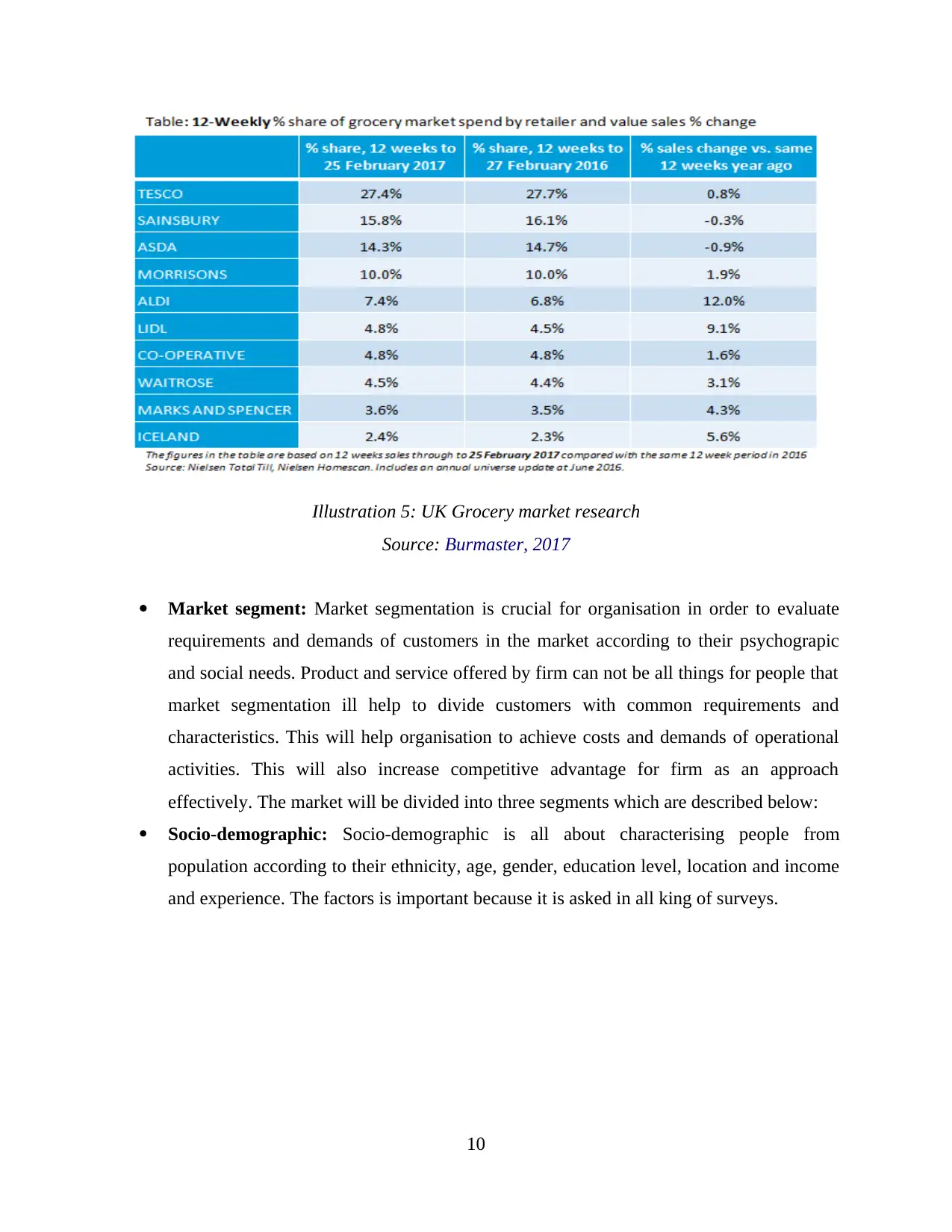
Illustration 5: UK Grocery market research
Source: Burmaster, 2017
Market segment: Market segmentation is crucial for organisation in order to evaluate
requirements and demands of customers in the market according to their psychograpic
and social needs. Product and service offered by firm can not be all things for people that
market segmentation ill help to divide customers with common requirements and
characteristics. This will help organisation to achieve costs and demands of operational
activities. This will also increase competitive advantage for firm as an approach
effectively. The market will be divided into three segments which are described below:
Socio-demographic: Socio-demographic is all about characterising people from
population according to their ethnicity, age, gender, education level, location and income
and experience. The factors is important because it is asked in all king of surveys.
10
Source: Burmaster, 2017
Market segment: Market segmentation is crucial for organisation in order to evaluate
requirements and demands of customers in the market according to their psychograpic
and social needs. Product and service offered by firm can not be all things for people that
market segmentation ill help to divide customers with common requirements and
characteristics. This will help organisation to achieve costs and demands of operational
activities. This will also increase competitive advantage for firm as an approach
effectively. The market will be divided into three segments which are described below:
Socio-demographic: Socio-demographic is all about characterising people from
population according to their ethnicity, age, gender, education level, location and income
and experience. The factors is important because it is asked in all king of surveys.
10
⊘ This is a preview!⊘
Do you want full access?
Subscribe today to unlock all pages.

Trusted by 1+ million students worldwide
1 out of 22
Related Documents
Your All-in-One AI-Powered Toolkit for Academic Success.
+13062052269
info@desklib.com
Available 24*7 on WhatsApp / Email
![[object Object]](/_next/static/media/star-bottom.7253800d.svg)
Unlock your academic potential
Copyright © 2020–2025 A2Z Services. All Rights Reserved. Developed and managed by ZUCOL.





